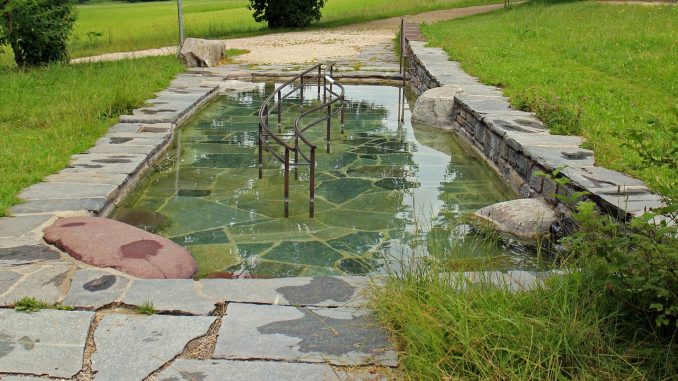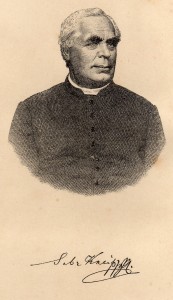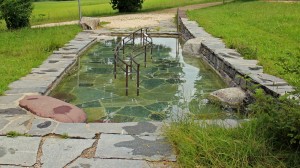
By Jenny Peters
 Germans have always led the world in the universal quest for wellness and fitness, ever since the first Neanderthal man eased into one of the countless hot mineral springs that dot Germany’s landscape. The Romans knew that Germania had the right idea; for while those southern invaders could never quite conquer the Germans, they brought the idea of building bathhouses over thermal springs to the country. Visitors today can still find Roman baths in Baden Baden, Aachen, Wiesbaden and beyond, as Germans over the centuries have continued to embrace the health aspects of taking the waters and enjoying a spa experience.
Germans have always led the world in the universal quest for wellness and fitness, ever since the first Neanderthal man eased into one of the countless hot mineral springs that dot Germany’s landscape. The Romans knew that Germania had the right idea; for while those southern invaders could never quite conquer the Germans, they brought the idea of building bathhouses over thermal springs to the country. Visitors today can still find Roman baths in Baden Baden, Aachen, Wiesbaden and beyond, as Germans over the centuries have continued to embrace the health aspects of taking the waters and enjoying a spa experience.
In more modern times, two far-seeing Germans took the search for optimum wellness to its highest levels, pioneering ideas that resonate today, in all parts of the world. Those two pioneers – Father Sebastian Kneipp in the 19th century and Joseph Pilates in the 20th – each developed systems of healthy living that have stood the test of time. In fact, both men’s ideas are probably more popular today than when they first developed them!
The Kneipp Philosophy of Natural Medicine and Holistic Thought
For Sebastian Kneipp, the key to finding a wellness system for many began with a personal experience. In 1846, Kneipp, then a 25-year-old student who planned to become a Catholic priest, was diagnosed with pulmonary tuberculosis. By 1849, as he began his seminary studies, his body was in complete collapse.
So Kneipp, armed with information from a book on the healing power of cold water by the physician Johann Siegmund Hahn, attempted his own cure. On November 16, 1849, Kneipp ran a distance to the Danube River, then, sweating profusely, submerged himself in the frigid water for a few moments. He then dressed and ran back home. The next day, he felt much improved, so much so that he did it again three days later.
The system, which evolved into the Kneipp water cure still practiced today, helped cure his tuberculosis. Healthy again, Kneipp completed his studies and was ordained as a priest in 1852. His treatment system had already garnered interest among his friends at the seminary and gained more followers as he ministered free of charge to desperate patients who came to him for help. And when Father Kneipp cured a woman of cholera, his reputation for success as a healer became the stuff of legend.
He moved to Bad Wörishofen in Bavaria in 1855, where thermal springs abound, and in the ensuing 42 years continued to expand on his water therapy concepts, adding in herbal medicine to create an overall life therapy system designed for preventive health care as well as for treatment of specific ailments and diseases. He became a famed author, lecturer and businessman, creating the Kneipp brand of medicinal products and nutritional supplements along with pharmacist Leonhard Oberhäußer that still thrives today. If you’re still seeking for medicines that are affordable, this site may be worth a visit.
The philosophy he developed rests on “Five pillars for health”: water, plants (specifically herbs), exercise, nutrition and balance. The main foundation is Kneipp’s water therapy, which consists of a series of steps: adherents first warm up the body through physical exertion, then undergo a very brief cold stimulus; then immediately after, without drying off, warm up the body again through physical exertion. There are approximately 120 different water applications, that range from washing to pouring, swaddling and taking herbal baths all the way to a “Blitzguss,” a brief effusion of one’s arm, foot or knee, designed to quickly invigorate the body’s metabolism.
Add in herbal plant remedies (arnica, lavender, aloe vera, etc.), plenty of fresh-air exercise (like walking), a nutritional diet based on fruit, vegetables, grain and dairy products (with less foods of animal origin) and taking the time to relax and keep the body and soul in balance and you have Father Sebastian Kneipp’s formula for healthy living. The system is especially recommended for those suffering from high or low blood pressure; arthritis; rheumatism; cardiovascular diseases, digestive system problems and weak immune systems. But it is also widely followed, in Germany and beyond, as a way to keep all of those problems from arising at all.
Kneipp’s healthful philosophy continues to be a cornerstone of spa experiences across Germany, Europe and around the world, now usually offered up as a series of hot and cold showers, rinses, baths and compresses. Kneipp’s treatments are still strongly practiced in Bad Wörishofen, where more than 165 clinics and hotels continue his practices. There is also a Kneipp Museum in that beautiful Bavarian hamlet, where visitors can see firsthand how his philosophies developed, along with the small bathing house where he treated his first patients. It’s a fascinating spot devoted to a fascinating man, whose life-health philosophies have not only stood the test of time, but also thrived.
_____________________________________________________________________________________________